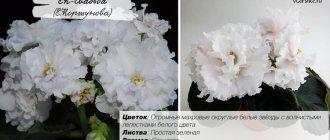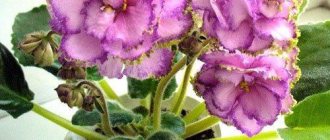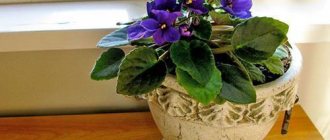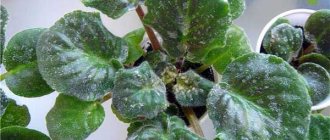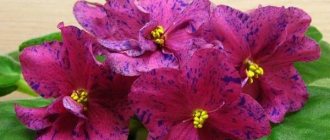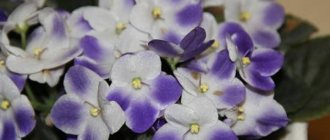The history of the flower
It’s quite difficult to even name the homeland of violets.
It grows in Japan, North America, Australia and New Zealand. But it came to Europe from the shores of East Africa.
According to one of the stories about violets, the commandant of German East Africa, Adalbert von Saint-Paul, was walking in the Usambara Mountains with his bride.
She noticed an inconspicuous purple flower between the stones, which had an unsurpassed aroma.
By a lucky coincidence, the commandant’s father was the president of the German Dendrological Society, Ulrich Saint-Paul, to whom the seeds of a flower were sent, “which glows with pale blue fire,” as Adalbert wrote about him in his diaries.
The discoverer's father gave them to the botanist Hermann Wenland, who confirmed that it was a new flower and named it "Saintpaulia" in honor of Adalbert von Saint-Paul.
Violet conquered Europe already at the first exhibition, which was held in Belgium, and at the beginning of the twentieth century, the conquest of the United States began, where a specialized society was opened that was engaged in breeding new varieties of the flower.
Note ! Violet growing wild was familiar back in ancient Greece, where myths and legends were composed about it. But it gained real popularity only in the 19th century.
To date, botanists have managed to develop several thousand varieties of color, despite the fact that initially about 20 species were known.
What pests are typical for violets?
To avoid getting various types of parasites on the plant, you need to know everything about them in advance. The most common and frequent cases of infection are the following pests.
- The mite cannot be identified on the surface of the plant, since it is microscopic in size. The presence of this parasite is determined by its “work”: there are characteristic chocolate-colored spots on the inside of the leaf. Arcacids will be needed to combat this parasite.
- Aphid. This type of pest, like mites, is very small in size. The most serious problem with aphids is their overly active reproduction. Negative consequences can be easily avoided if small insects are detected in time near the buds and on the underside of the leaf. There are three types of pest control at once: mechanical assembly, removal of affected areas and places where pests are localized, as well as treating the plant with a solution of laundry soap.
- Thrips are clearly visible to the naked eye, so detecting their presence in time will not be difficult. At the usual stage, thrips are localized on the underside of the leaf, but when it is time to reproduce, they actively move throughout the entire area of the plant. Another complicating factor is that they are able to lay their offspring throughout the flower. A characteristic feature of the definition of thrips is the discoloration of some parts of the plant. You can fight them with any of the known drugs of this specialization. The problem is that pests adapt at a rapid rate, making it difficult to select the right chemical.
- The appearance of scale insects is considered a common practice. They often get onto the plant through nearby “neighbors”. The problem with the scale insect is its fertility: even one pest can infest an entire indoor plant with its offspring. She, like thrips, sucks the cell sap from the violet. It can be identified by the characteristic bald spots on the green background of a healthy leaf. The delicate leaves of violet, in the case of scale insects, are not susceptible to any other influence other than mechanical. Pests should be removed with soapy water. But experts recommend destroying the plant, because it spreads the infection.
Thus, we can say that despite being innovative in some respects, the Magic Tulip violet has the basic qualities: the pros and cons of a standard houseplant.
For those who like to collect and collect all kinds of colors and shapes of plants, it is an excellent specimen.
You can learn more about how to root a violet leaf below.
Types of wild violets
Wild violet is distributed on almost all continents.
Flowers differ according to species and grow in different climatic conditions. Wild plants are different from the violet that has become a houseplant . For wild species of Saintpaulia you need to go to Africa.
About 20 species of wild violets grow on the mountain slopes and waterfalls of Tanzania and Kenya. The flower does not tolerate bright sunlight, so it prefers shaded, damp areas.
The most common and beautiful are the following 3 types:
- “Velvet” Saintpaulia . It is characterized by dark green leaves measuring no more than 5 centimeters. A red tint can be seen on the back of the leaf. The inflorescences are lush, and the flowers are blue-violet, the core is dark.
- “Grote” is a hanging plant. The leaf comes in a purple hue or bright green. Its length reaches 6 cm, and the maximum width is 5 cm. The flowers have a blue-purple hue, with an almost black eye and border.
- “Violet flower” is distinguished by a large rosette, reaching a diameter of more than 50 centimeters. The stems are shortened, the dark green leaves are heart-shaped, the length of which can reach 8 centimeters. The flowers are blue-violet in color.
Note ! Today, many species of wild violets are listed in the Red Book. For example, purple violet is found only in the Caucasus mountains.
In Europe you can see “Forest”, “Amazing” and “Frost-resistant” violets. But they are cultivated quite rarely, being more used as a landscape element. In total, there are more than 25 species of this plant in Eurasia.
Note! On our website there is a series of materials devoted to caring for Saintpaulias: how to grow a plant from a leaf, how to water it correctly, choose a pot and replant. And also how to propagate this plant.
Care techniques in indoor culture
Violet responds favorably to the careful implementation of the simplest, but very necessary agrotechnical measures, provided they are carried out with mandatory regularity:
- The plant should be placed on a window facing west or east; specimens from windows to the north should be provided with additional rays with a diffuse spectrum; to the south, unobtrusive artificial protection is required. When young, the variety prefers placement on shelves;
- Watering is indicated in small doses from the moment when slight drying of the upper volume of the substrate is visually clearly visible;
- Apply additional fertilizing mineral fertilizers best of all, focusing on the state of the bush’s decorativeness;
For violets, it is necessary to create suitable conditions for growth. - Provide light primarily during the day, long-lasting, with a spectrum of scattered rays;
- Control a constant heat level within +18 + 24°C ; eliminate sudden fluctuations in the temperature gradient;
- Plant the rosette in nutritious, permeable soil with good aeration; ensure the creation of a volumetric drainage layer;
- When transplanting , use transshipment more often if there are no special indications.
Varieties of indoor violets
Today you can see many cultivated violets, differing in size, shape and shades of leaves, number and shade of petals.
Often one variety has several groups that are slightly different from each other. So, the classification of violets occurs according to the following criteria.
According to socket size
Mini and semi-mini violets are becoming increasingly popular
Plants with a rosette with a diameter of 20-40 centimeters are standard.
If the diameter does not exceed 20 centimeters, it is a semi-mini variety.
Note ! Semi-mini violets do not tolerate excess sunlight.
Plants planted in unshaded areas become sick, the rosette becomes flat, and the foliage turns yellow.
Expert opinion
Nesterenko Ilona Mikhailovna
Florist, specialist in indoor plants. The owner of a country house with a garden and vegetable garden
Mini varieties have a rosette diameter of 12 to 15 centimeters, they are not picky, reproduce well and take root, which makes the plant ideal for growing in the garden.
Tiny compared to standard micromini varieties, they are distinguished by a rosette with a diameter of no more than 8 centimeters. They are grown exclusively indoors and die quickly without water.
Varieties with a compact rosette include, for example, the “Raisin” violet.
Violet “Raisin”
By flower size
Depending on the size of the flower, violets are divided into small-flowered (less than 2 cm), medium-flowered (up to 4 cm), large-flowered (up to 6 cm) and especially large-flowered (more than 6 cm).
According to the shape of the flower
Today, violets are divided into 5 main types. A distinctive feature is the size and arrangement of flowers. You can read more about them below.
Pansies
This type of flower has 5 petals arranged in 2 rows.
The top 2 leaves are smaller than the bottom 3.
The most popular varieties related to Pansies are the following:
- “Lians Pirates Treasure” is a pink flower with a wide crimson border at the edges of the petals. You can see raspberry patches on the border. The leaves have a bubbly structure.
Violet Lines Pirates Treasure - Violets “Cinderella’s Dream” are distinguished by large lace flowers of a light lilac color with a crimson tint. The upper petals are darker than the lower ones. The rosette is made up of green wavy leaves of a dark shade.
- The rosette of “Kimi Melody” is made up of leaf plates. The lower petals of the flower are white with a blue border. The top ones are also blue.
Violet Cinderella's dream
Violet Melodies Kimi
These are not all varieties, since Pansy is one of the most common varieties in the world. But it is simply impossible to mention everything, because you will have to write a multi-volume edition.
Star
A star can be distinguished from others by the same size and symmetry of the flower petals. Among the many varieties, the following stand out:
- “Kev's Heavenly Star” is a rather simple pink flower that resembles a double star. All petals have a dark border.
- The petals of the “Magic of Love” flower resemble ceremonial pompoms in a solid burgundy color. The beet tint and the border of snow-white petals add special chic.
- Double red flowers are characteristic of “Black Prince”. Its rosette is standard, but the sheet on the reverse side has a red tint.
Violet Magic of love
Violet Black Prince
Other popular varieties of Saintpaulia include Rosemary, Zephyr and Austin Smiles. These and many other varieties have won great love among gardeners, but require a lot of attention to care.
Violet “Rosemary”
Violet “Zephyr”
Violet “Austin Smiles”
Note ! Creamy white petals with coral specks turn white when exposed to high temperatures. The plant should be planted in shaded areas.
Bell
Violets belonging to the Bluebells do not open completely, merging at the beginning of the petal. The most common varieties are the following:
- “Admiral” of blue-cornflower blue color is distinguished by semi-double wavy flower petals. The dark green leaves are pointed and decorated with purple edging.
- The blue flowers of “Shining Bell” have wavy edges and a fancy pattern. You can see a yellow peephole inside.
- The “Chanson” variety blooms brightly and for a long time. Flowers are unpretentious. The rosette contains a large number of dark blue, violet and purple flowers.
Among others, one should especially highlight “Robs Dandy Lion”, which in shape and color is quite easily confused with a snowdrop.
The varieties “Royal Lace” and “Wedding Bouquet” boast beautiful white flowers and abundant flowering.
Bowl
This type of color is in many ways similar in features to the “Bell”, but the petals do not grow together at the base and do not open fully. The result is a cup-shaped shape.
The most popular are the soft blue “Boo Man” and the white and pink flowers of the “Ming Dynasty” variety.
Wasp
The petals of this type of violet are separated from each other. Two of them curl into a tube, and three are slightly longer and hang down. From a large group, the following stand out:
- “Lunar Lily White” is a variety that has about 6 double white flowers in an inflorescence with a diameter of up to 4 centimeters.
- The lilac petals of “Zemfira” flowers have both double and simple structure. The rosette is ordinary, but has variegated leaves in the center.
- The rosette of “Sputnik” is quite small (no more than 15 cm), the flowers are colored red-violet.
Violet “Lunar Lily White”
Violet “Zemfira”
In addition to the above types, violets are divided according to a number of other criteria, which will be discussed below.
By degree of terry
Violets are divided into simple, scalloped, semi-double, double and “carnation”.
The first are flowers with 5 petals.
Comb violets are those that have five developed petals and several underdeveloped ones . Saintpaulias with 8 petals, in which the stamens are visible, are semi-double, and flowers with 10 or more petals are double.
Carnations can be confused with double carnations, but they have more petals and are different in size.
Along the edge of the petal
Depending on the edge of the petal, the flowers are divided into fringed, wavy and notched.
By color
Houseplants are also divided according to flower color; detailed information is provided below.
Plain
This type of violet has one tone of petal color, but there are a huge number of color varieties.
You can even find green violets.
The most interesting representatives of this type are “Blue Teal Fly”, which belongs to the “wasps”, and “Gillian” - a representative of the “carnations”.
Violet “Blue Teal Fly”
Violet “Gillian”
Two-tone
Here, too, everything is quite simple - the flower petals are painted in 2 shades of one of the many colors. The color form varies.
Most often, shadows or thickening of color from the central part to the edges are observed.
Interesting representatives are “Ice Rose”, “Amadeus”, “Marie-Sylvia”, “Rum Punch”, “Frosty Cherry”.
Violet “Amadeus”
Violet “Ice Rose”
Violet “Rum Punch”
Violet “Frosty Cherry”
Two-color or multi-color
In this case, most often you can see petals of the same color with a border painted in a shade of contrasting color. Most often, gardeners can find violets of the “Iceberg” and “Through the Looking Glass” varieties.
Violet “Iceberg”
Note ! A number of varieties have not one, but two borders. A striking example of this is the “Looking Glass” violets.
Violet “Looking Glass”
Limbed
These varieties of violets that have one or more edgings include the varieties Windrose, Natalis, Estravagante, Macho, Modern Talking and others.
Violet “Modern Talking”
Violet “Macho”
Finger color
Looking at a violet of this variety, you might think that it was doused with paint and then smeared with your finger. The strokes are most often found in the middle of the petal, but not always. Prominent representatives are “Crimson Ice” and “Southern Spring”.
Finger-colored violet
Peephole
In Eyes, the flower petals are painted in one color, but in the middle there is a speck with a color that matches the main color or, conversely, a contrasting shade. The most famous variety is “EK-8 March”.
Violet “EK-8 March”
Mesh
This color is formed due to the contrasting veins on the petals. It can boast of rare varieties, including “Granger”, “Carnival” and “Feather”.
Violet “Carnival”
Chimera violets
The color of the chimera is similar to a mesh, but the stripes go from the middle, and they are of different colors. The most striking representatives are the varieties “Chain Reaction” and “Queen Sabrina”.
Violet “Queen Sabrina”
Violet “Chain Reaction”
Fantasy
The name of this type of color speaks for itself. These are flowers of different colors with bizarre shapes and patterns. Some of the most beautiful are “Chimpansy” and “Live wire”.
Violet “Live wire”
Violet “Chimpansi”
A striking example is the Dance of Galaxies.
Violet “Dance of the Galaxy”
Red Saintpaulias
Red Saintpaulias or Uzambara violets are considered the most popular among this type of flower; they simply attract the eye with their bright colors. But unfortunately, breeders have managed to develop not so many varieties of red violets, so burgundy and coral shades are classified as red. There are more than one and a half thousand varieties of red Saintpaulias, the most popular of them are listed below.
Saintpaulia variety Ataman
Ataman is a variety of Saintpaulia that is difficult to grow; it is very delicate and demanding in terms of conditions, but as a result, Ataman will delight you with abundant and lush flowering.
Ataman Saintpaulia variety
Breeder: B. Makuni Flowers: Large, double, the surface of the petals is velvety. The color of the flower is bright cherry, the edge is decorated with a wavy white edging. Leaves: The leaves are ordinary, slightly elongated, dark green in color. Socket: Regular compact, standard size.
Saintpaulia varieties Bullfight
Saintpaulia varieties Bullfight
In international catalogues, the variety is called EK-Boy Bykov. This variety is attractive with its unusual flowers, bright and very large; the flowers grow from 7 to 8 cm. The variety is relatively unpretentious and requires compliance with the light regime.
Breeder: Korshunova E. Flowers: Very large, dark red, star-shaped. Peduncles grow in the shape of a bouquet. Leaves: Bright green, elongated oval shape Rosette: Smooth compact, standard size.
Saintpaulia variety Gladiator
Saintpaulia variety Gladiator
In international catalogs the variety is called EK-Gladiator. The gladiator will not cause difficulties or problems in growing and caring for. This is a fairly unpretentious Saintpaulia that even a beginner can grow.
Breeder: Korshunova E. Flowers: Dark red, rather large, semi-double, star-shaped. Leaves: Dark green, regular shape Rosette: Neat, compact, standard size.
Saintpaulia varieties Spanish dance
Saintpaulia variety Spanish dance
In international catalogs the variety is called LE-Spanish Dance. This Saintpaulia will not cause any particular difficulties in care; if you follow the necessary rules, it will delight you with abundant flowering. Flowering is bright and very abundant and very long, can last up to six months without interruption.
Breeder: E. Lebetskaya Flowers: Dark red in color, can be either double or semi-double, decorated along the edge with a thin white line. Disadvantage - after a week they gradually begin to lose color - they fade. Leaves: Green, ordinary. Rosette: Smooth, medium size.
Saintpaulia variety Magenta
Saintpaulia variety Magenta
In international catalogs the variety is called LE-Magenta. A very bright and beautiful variety, it grows quickly and begins flowering early. If the lighting regime is observed, flowering is long and lasting. In insufficient light, flower stalks may stretch out and fall onto the leaves.
Breeder: Lebetskaya E. Flowers: Bright red-burgundy color, double, very lush. The edges of the petals are decorated with a thin white border. Leaves: Light green, slightly pointed. Socket: Compact, standard size.
Saintpaulia varieties Frosty cherry
Saintpaulia variety Frosty cherry
This plant will decorate your windowsill with very bright and beautiful flowers; the color saturation depends on the lighting conditions. If there is not enough light, the flowers will be light. The variety is demanding in maintaining temperature conditions and does not tolerate high humidity.
Breeder: Morev K. Flowers: Cherry red, with a white spot in the center of the flower, decorated with a white border along the edges, can be either double or semi-double. They are shaped like a star. Within 2-3 days after blooming, the color of the flower becomes more saturated. Leaves: Dark green, regular. Socket: Compact, standard size.
Saintpaulia variety Ness' Orange Pekoe
Saintpaulia variety Ness Orange Pekoe
This violet can be classified as a retro variety; it appeared at the end of the last century. The variety is unpretentious in cultivation and care, grows well, blooms early and abundantly. Violet loves good lighting and does not tolerate heat well; in conditions of elevated temperatures, the variegation of the leaves may be lost.
Breeder: D. Ness Flowers: Large flowers of red coral color, can be either double or semi-double. Leaves: This is a variegated variety, the leaves are dark green, streaked with cream and pink, with a red underside. Socket: Large, neat.
Saintpaulia varieties Fire moths
Saintpaulia variety Fire moths
This variety is attractive for its unusual flowers; as it blooms, the wide border changes color, from white to light green. The variety is relatively unpretentious and requires compliance with the light regime.
Breeder: Morev K. Flowers: Dark red or dark crimson, petals are decorated with a wide border two tones lighter than the main color, and a thin white border. They can be either simple or semi-double. Leaves: Green, usually oval in shape, can be folded into a spoon. Socket: Standard size.
Saintpaulia variety Oksana
Saintpaulia variety Oksana
In international catalogs the variety is called LE-Oksana. This variety is relatively new, released in 2015. A very bright and beautiful variety, it grows quickly and begins flowering early.
Breeder: Lebetskaya E. Flowers: Red-burgundy color, simple, quite large, shaped like a star. The edge of the flower is decorated with a white wavy border. Leaves: Oval, elongated, variegated, green with white edges. Socket: Neat, standard size.
Saintpaulia variety Proserpina
Saintpaulia variety Proserpina
In international catalogs the variety is called JuS-Proserpina. This variety is attractive with its unusual fancy flowers and frequent, long-lasting flowering. The variety is relatively unpretentious and requires compliance with the light regime.
Breeder: Jura S. Flowers: Very large, red-violet with pink stripes and spots Leaves: Dark green, medium size. Socket: Compact standard size.
www.art-pen.ru
Ampelous
Ampelous varieties are a fairly young type of violet with a long stem and a variegated color of different colors. Some of the most beautiful are “Ramblin Dots” and “Fallin Snow”.
Violet “Ramblin Dots”
Violet “Foline Snow”
Course of life stages
The main activities for caring for the variety are greatly simplified due to the fact that the phases of its life processes correspond in time to the standard development periods of many beauties of the genus.
ATTENTION! You can create regimes based on the model and adjust the system in accordance with the nuances of the variety.
Specificity of development in indoor collections
Varietal Saintpaulia does not very easily begin to develop a leaf rosette, sometimes waiting for help in the formation of a bush from the grower.
The growth of green mass occurs over a long period of time, during which Saintpaulia is in no hurry to lay buds .
An adult plant gains strength and then develops quite simply, without being capricious about:
- Room microclimate;
- And methods of agrotechnical care.
Accuracy in the formation of a bush can be achieved:
- By placing a flowerpot with a growing plant on the shelves of a rack - here Saintpaulia more willingly places its leaves in even boundaries, forming a compact specimen;
- Then it is more advisable to move the violet to the window, since its flowers prefer somewhat cool conditions - while the shape of the corolla retains its original outline longer.
In addition, the variety loves an abundance of natural light , while increasing the size of the corollas and showing greater intensity of their color.
But you should be careful about the sun’s rays, as the variety reacts negatively to their excess by causing woodiness of the leaf blades.
The turn of flowering begins only after the final appearance of the decorative appearance of the bush, and its maximum forms increase gradually. Approximately by the third or fourth stage of flowering, a large volume of large flowers will appear, but the type of flowering will not reach the cap - Saintpaulia will rather present a bouquet of tulips scattered in different directions.
One of the main disadvantages of the variety is the decrease in strength in the texture of the peduncles after the buds begin to bloom, due to which the flowers mostly lie on the rosette - but this is a varietal feature of Saintpaulia.
Features of reproduction
Only two vegetative methods are possible for obtaining young specimens of violets:
- Children from leaf cuttings;
- Stepchildren from the mother plant.
Propagation of violets using seeds is considered impractical.
Response to heat in flowers
The appearance of violet flowers is highly dependent on the heat gradient :
- The color in a hot microclimate is thicker than in a cool climate;
- Flowers quickly wither in hot weather, but at low temperatures they confidently retain their silhouette.
CAREFULLY! Violet flowers and buds fall off extremely sharply due to changes in heat and drafts!
Pedicel strength
The peduncles of the violet are greatly elongated , due to which the heavy flowers lie on the leaves of the rosette.
Flowering type
The violet cannot form a sufficiently voluminous cap due to:
- Weakness of peduncles;
- The heaviness of the buds;
- And the rapid wilting of flowers when the temperature rises.
The violet does not bloom magnificently and abundantly.
Flower lifespan
In a cool microclimate, each flower can remain fresh for almost three weeks; in hot weather, it dies twice as sooner.
The most popular varieties
Among the most common varieties are the following:
- “Isadora” is a flower somewhat reminiscent of peonies.
- “Lituanica” - looks like a mixture of tea rose, dahlia and rosehip.
- “Rosemary” is one of the most delicate representatives of violets with a beautiful purple pattern on a pink background.
Violet “Isadora”
Violet “Lituanica”
Violet “Rosemary”
Of course, these are not all varieties loved by many. You can also note “Darling”, “Paul Bunyan”, “Duchess” and others.
Violet “Paul Bunyan”
Breeder Natalya Skornyakova
The breeder of the new millennium, Natalya Skornyakova, lives in Kursk, where she is breeding new varieties of violets in tandem with another breeder Tatyana Pugacheva. Each of them represents its own varieties. All items in Natalia's collection have the prefix RM in their names . It turns out that these are the initials of the breeder’s mother, to whom she dedicates the fruits of her work.
Reference! The girls have their own website “Kursk Violet”, which contains a catalog of their works. Here you can not only admire beautiful flowers, but also order leaf cuttings and children of your favorite specimens for yourself at an affordable price.
The most unusual violets
It should be noted that this flower can be quite unusual, for which it is highly valued by flower growers, because you never know what the outcome will be. The most interesting varieties are the following:
- “Chimera” is a variety resulting from the mutation of two plant species. The color of the petals varies from blue to crimson, but there is always a light dividing line in the middle.
- An exotic variety called “Crimson Cloud Country” has a dark crimson color with an intricate pattern.
- “Gray Ocean” is a flower that has the ability to change color to suit the mood, turning from white to lilac. With each flowering it becomes darker, and the Gray Ocean variety turns into the Black Pearl.
Violet “Chimera”
Violet “Land of Crimson Clouds”
Violet “Grey Ocean”
There are a lot of varieties of violets; every year breeders try to present something new and unique at exhibitions, so it is not possible to mention them all. But each of the varieties is unique and beautiful in its own way.
The article examined the main varieties of indoor violets. This is a beautiful flower that can decorate any space.
For those who are interested in this plant, but have no experience in growing it, we recommend starting with mini violets. Exhibition varieties are more beautiful, but have a lot of nuances in breeding, which will turn a hobby into exhausting work.
However, regardless of the choice, the interior of the room, decorated with live violets, will be transformed beyond recognition.
We recently learned that there are quite a lot of signs and superstitions associated with this plant. Read about them in the material at the link.
How to care for red violet at home: growing rules
Among the many varieties that differ in the shades and colors of the petals, violets with red flowers are becoming increasingly popular. There are a huge number of varieties with petals in red shades. There are specimens with uniformly colored petals, edged at the edges, with various spots of varying intensity, and so on. Their flowers can be double or semi-double, their size on average is about 6 cm. The red color of the petals can become a bright accent in any interior. Flowers are usually collected in inflorescences of 2 or 4. Thanks to the compact size of the rosette itself and the inflorescences, violet will harmoniously decorate a small shelf, coffee table or window sill.
Violets are often used to decorate events; as a rule, they are placed on tables. When buying violets in a store, you need to carefully examine the plant you like. There should be no spots on the foliage, any white spots, plaque or black spots indicate that the plant is not healthy.
If you are not purchasing a violet, but only its leaves, then you need to choose specimens from the middle row. There is no need to take the lower leaves, as they usually suffer from a lack of light and are therefore weaker. Babies may not appear on such leaves. In a regular flower shop, the violet variety may not be indicated, so you should ask the seller if there is a name for the variety.
Original varieties of Saintpaulia are sold only at specialized exhibitions and in nurseries, but their cost is much higher than usual. In order for the purchased violet to take root at home and for the leaves to take root well, it is necessary to properly care for the violets and keep them in the required conditions.
How to care for violet
The red color of the flowers will undoubtedly not leave any flower lover indifferent. Such flowers will harmoniously fit into any interior and will attract attention with their bright petals. Prolonged and abundant flowering of violets will ensure proper and attentive care.
Lighting
Violet loves light and warmth. But its leaves are so delicate that exposure to sunlight on them can cause burns. Therefore, to find the ideal place to place this flower, it must meet several conditions. The place should be well lit. Therefore, windows facing east, west and south are suitable.
Northern windows are not suitable for growing violets. Direct rays of the sun should not fall on the violet. On windows on the east and west sides, this condition will be easier to comply with than on the south. But southern windows are also suitable if the glass is covered with diffusing material. You can use blinds, thick paper or fabric.
Temperature requirements
Despite the fact that violets come from the hot continent of Africa, they do not tolerate heat well. The optimal temperature for keeping them is considered to be +18 – 24 degrees. If the indicator drops below, then the red Saintpaulia stops growing. And in combination with high humidity, low temperatures can provoke the development of root rot.
Watering and humidity conditions
Violet is very sensitive to excess moisture; even slight stagnation of water and waterlogging can destroy the root system, and with it the flower. Therefore, it is best to water after the soil in the pot dries out. It is better to water from above a couple of times a month; the rest of the watering is carried out using the submersible method or from a tray.
These two methods will minimize the risk of soil waterlogging and allow moisture to be distributed evenly. Air humidity, while maintaining the required room temperature, should be at the level of 60–70%. Trays with drainage will help provide such moist air. This can be moistened expanded clay, gravel, pebbles, and so on. You can spray the flower from above, but it is better to do this when the room temperature is not lower than 23 degrees and not higher than 25.
Spraying in a cool room will cause rot spots to form on the leaves.
Feeding
Violet needs feeding. If you used purchased soil when transplanting violets from a store pot, you do not need to fertilize often. Such soil already contains all the necessary elements. If you mixed the soil yourself, then you need to fertilize it. It is better to do this with watering.
During the budding period, fertilizers with a predominant proportion of phosphorus in the composition are used. It helps to form stronger, brighter and healthier buds that bloom into large, lush flowers. Young plants first need to develop a root system and greenery, so fertilizers with a predominance of nitrogen are selected for them, which promotes the growth of succulent large leaves.
Choosing a pot and soil
Violet is quite picky about the soil and the pot in which it grows. For young plants that have just been rooted or propagated, pots 6 cm in diameter are most suitable.
Adult plants need a pot twice as large, that is, 11-12 cm. In a pot that is too large, the violet will not bloom for a long time. First, she will fill all the free space in the pot with roots. There is a rule for choosing a pot - its size should be three times smaller than the outlet. The material from which the pots are made may vary. Ceramic, plastic or glass pots are suitable.
External care
In adult violets, old leaves periodically die off. Therefore they need to be removed. Sometimes you need to add soil to the pot, and then cover the top with moss. Faded and dried buds also need to be removed.
Violet is not considered a very whimsical and capricious plant, and caring for it is not as difficult as it seems. It is enough to provide her with the necessary conditions of detention. It is much more convenient to grow violets several at a time. You can organize a separate rack or place for them.
For several plants, it will be more rational and convenient to provide the required humidity and temperature; in addition, you can install a source of artificial lighting to highlight the plants. Then your flower garden will immediately have a collection of these wonderful plants, and caring for them will be easier.
www.pro100-cvety.ru
Violet Neon carnation (E. Lebetskaya)
LE-Neon carnation belongs to the Uzambor violets, a genus of hybrid Saintpaulias, of the Gesneriev family. The variety was recently bred by domestic breeder E. Lebetskaya.
Beautiful violet Neon carnation.
The rosette is compact and medium in size, but under certain circumstances it is prone to elongation of leaves . Flowers:
- Large;
- Semi-double with ruffled edge.
Saintpaulia color
- Deep pink;
- Close to fuccia;
- A white-light green border may appear along the edge.
Important! Usually it forms many peduncles and each has three to four buds, which ensures flowering in a cap.
Care
Neon carnation is no more demanding to care for than other varieties. Lighting should be plentiful but without direct sunlight. The temperature is maintained within 16-22°C in accordance with the season.
The soil is chosen at your own discretion, but it is recommended to use a ready-made substrate for Saintpaulia or a mixture:
- Peat/perlite/leaf soil/sphagnum moss in the proportion 1/1/1/0.5-0.8;
- And also peat/perlite in a 1/1 ratio (ideal for wick irrigation).
Watering is carried out in one of three ways :
- into a tray - into a container where pots with violets are pre-installed, up to 2 cm deep. After 20 minutes, the remaining water is drained. Fertilizers are applied through irrigation and the concentration is halved from that recommended by the manufacturer;
- Under the leaves - it is recommended to place the pots on pallets, and pour water onto the ground, avoiding contact with the leaves. After some time, excess water is drained from the pan. Fertilizers are applied as in the previous method;
- Wick - water is poured into a container, and a wick passed through the pot is lowered into it. Fertilizers are constantly added to the water, and their concentration is reduced by 7-8 times the recommended value.
Reviews
Many gardeners want to get this variety for themselves.
Catherine. “I bought a baby Neon Carnation. It grew quite slowly, but I think the problem is in the conditions of care, because all my flowers are very slow. The first flowering pleased me; the color was simply beautiful, rich and at the same time delicate. The border along the corrugated edge looks very impressive.”
Alina. “Unfortunately, the purchased rosette disappeared immediately after flowering. I really liked the color and shape of the flowers, as well as the shape of the rosette itself. The good news is that after the purchase I cut off a few extra sheets and decided to root them. Each gave from two to four children, and now I will have this beautiful flower.”
Violet Pink carnation (E. Korshunova)
EK-Pink carnation is a Saintpaulia bred by breeder E. Korshunova . This variety belongs to the genus of hybrid Saintpaulias, the Gesneriev family.
Delicate violet Pink carnation.
The rosette is large with fleshy, dark green leaves , slightly curled downwards. Flowers:
- Large;
- Semi-double and terry;
- Three to five are placed on each powerful peduncle.
There are many flower stalks, usually blooming in a cap or bouquet .
Care
The variety does not require special care .
Each Saintpaulia requires certain care.
| Irrigation type | In the tray (under the leaves) — flowerpots with plants are placed on a stand up to two cm deep. Water is poured into the tray (under the leaves). After watering, excess water is drained after 20-30 minutes. — The frequency of watering depends on the need (when the soil dries out) in the summer about once a week, in the winter – one and a half to two weeks. | Wick - a wick is placed in the pot, it is taken out through the drainage hole and placed in a container with water, which is placed under the flowerpot. — Water is constantly in the container. |
| Primer (recommended) | — Ready-made substrate for violets (Saintpaulia) is well suited for these types of watering. — The mixture can be made at home from peat, leaf soil, perlite and sphagnum moss in a ratio of 3/3/3/2. | — A mixture of peat and perlite in a ratio of 1/1. — Other types of soil are also suitable, but may become waterlogged with such watering. |
| Lighting and temperature | Summer – 22-24° C. Daylight hours should be more than 12 hours (bright lighting but without direct sunlight) | |
| Winter – 16-18° C. Daylight hours are about 8-10 hours. | ||
| Spring, autumn - the temperature changes gradually, as does the length of daylight hours. | ||
| Feeding | — Mineral fertilizers are applied through irrigation. About once every two weeks in the summer, and once every three to four weeks in the winter. — It is recommended to reduce the concentration by half from what is indicated in the instructions. | — Subcortex is constantly added to the water. — The concentration should be 7-8 times less than that recommended by the manufacturer. |
After proper care, Saintpaulia will reward you with good flowering.
Advice! By changing the temperature and brightness of the light, you can slightly change the color of the flowers, from pale pink to almost white in dark places and at low temperatures, and dark pink with plenty of light and rising temperatures.
Reviews
Christina. “I bought a leaf of the EK-Pink Carnation variety and received two babies at once. It’s good that I didn’t give one away and received two carved rosettes. From the first flowering, one of them went clearly according to the variety, pink, double, only the cap flowering turned out to be the third time. But the second one gave a beautiful sport, double flowers and very beautiful pink and white with a small light green border. In the second flowering, the color was repeated, and there were enough peduncles and buds for a cap.”
Olga. “I bought a blooming rosette of a beautiful violet pink carnation. With each subsequent flowering it produced a persistent bouquet and was pleasing to the eye. Unfortunately, the bush did not survive the hot summer, but the leaves rooted in the spring pleased several children at once, some of whom eventually became sports.”
Useful video
Find out in the video how the Pink Carnation violet blooms:
Reviews
Natalia Gennadievna. “ I would like to advise all flower growers who dream of unsurpassed decorative flowering with a minimum of hassle to purchase the “RM-Red Ball” violet for the collection. This is a magnificent variety with the obvious makings of an ideal plant: it blooms amazingly, for a long time, with huge flowers, forms independently, and is not picky about conditions. The main thing is to regularly take care according to the prescribed schedule.”
Eduard Anatolyevich. “ Most varieties of N. Skornyakova are distinguished by compact rosette outlines, fairly simple care techniques, originality and duration of flowering, and decent repeatability during propagation. Violet “RM-Red Ball” is no exception - I can reliably confirm the positive characteristics of the variety, since I have been growing it since its appearance.”
This violet attracts many gardeners with its appearance.


